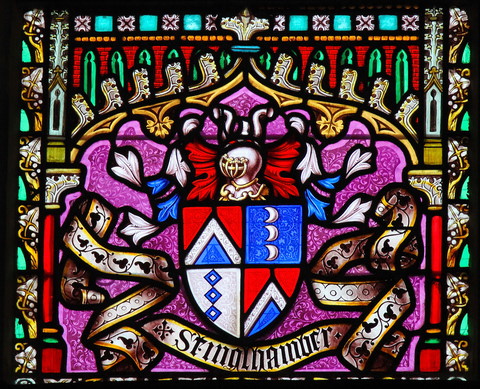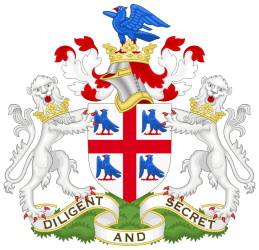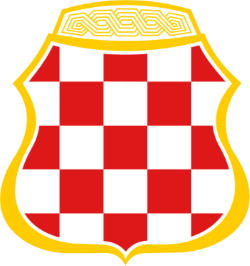This article is by by Toni Šušnjar.

Distinctive personal insignia on shields had been used to identify warriors in battle since 800 BC in Phrygia. But this insignia was not heraldry as it was not hereditary (familial). Heraldry appeared in mid-12th century, and flourished during 13th and 14th centuries. First formal heraldry in England appeared in 1127 when Henry I gave a shield to his son-in-law, Geoffrey Plantagenet, Count of Anjou, as a wedding present. Geoffrey’s shield would descend to his grandson. Development of heraldry was given impetus in 12th century crusades, especially the Third Crusade. Early shields were simple devices with one or two colours, and had no principles of heraldry or any semblance of standardization. This changed only in 1484 when Richard III founded College of Arms.
Heraldry is granted by king (or, rather, College of Arms) to:
- people (barons, knights, other individuals)
- places (counties, cities, boroughs, towns)
- institutions (armed forces, national services, companies, ecclesiastical arms)
Heraldry necessarily became more complex as more and more people were given right to bear arms. In France, by the 13th century many members of bourgeois were given right to bear arms, and by the end of the century that practice was widespread. This right spread further – first example of a peasant bearing arms occurs in 1369 (Jacquier le Brebiet – the shepherd; three sheep held by a girl). Nobility remained separated in the fact that neither bourgeoise nor peasants were given right to wear helmet crests. In Portugal and Germany as well burghers and peasants were given right to bear arms, though this right was rescinded in Portugal in 1512 when king Manuel I forbade non-nobles from bearing arms.
By cca 1500 the original purpose of heraldry was becoming obsolete, and thus insignia began to be more and more complex, assuming naturalistic rather than traditional symbolic forms. This event, cca 1550, marked the end of true heraldry, and thereafter the science declined.
Heralds existed as early as the 12th century, but at first they were only responsible for extolling deeds of knights at tournaments. They soon became responsible for organization of tournaments, and consequently became heraldry experts, responsible for identifying contestants by their insignia. From this familiarity also sprung their usefulness to military commanders, and they were expected to follow their lords and identify knights. Thus by the 14th century heralds became appointed officials and confidants of noble households, wearing livery of their lord – and also often spying on his behalf, as even in the mid-14th century they enjoyed diplomatic immunity. By the 14th century English Kings of Heralds were making surveys in their provinces of existing arms in order to reveal possible duplications.
These disputes necessitated an office which could relieve the sovereign of the task of regulating the bearing of arms. In France a College of Heralds was created in Paris in 1407 by Charles VI. In England it was in 1417 that Henry V prohibited unilateral assumption of arms, and also created a new heraldic officer, Garter Principal King of Arms of Englishmen, responsible for issuing Patents of Arms in England and Wales. In 1484 Richard III incorporated the College of Arms. German heralds had been active until 1700, whereupon they disappeared. Spanish and Danish heralds were, much like the French, relegated to secondary role by Kings.

Heraldic devices were highly influenced by their times – shape of shield and helmet can reveal time of origin of the device. Kite shield remained in usage throughout the 12th century, but soon the curved top was replaced by flat one, and infantry continued to use this new form until the 15th century. As shield was curved, much of the shield was out of sight and this influenced design of arms. In the early 13th century the kite shield was shortened into what is today called heater shield. As plate armour advanced, shields began to diminish in size. In 1360 – 1400 period shields were gradually abandoned by mounted men-at-arms, and by 15th century they were only used in parades and tournaments.
Principles of Heraldry
Basic element of heraldry are the shield, which carries a symbolical figure, and the helmet. Among members of Church, the helmet was replaced by the mitre, or else the cardinal’s hat. Heraldic signs may utilize only six basic colours – gold (Or), silver (Argent), blue (Azure), red (Gules), black (Sable) or green (Vert). On paper, parchment or cloth, gold and silver are replaced by yellow and white, respectively. Differences in colour tone are not allowed; each colour has only one variant.
Basic shape of the coat of arms is the shield. This fact necessitated stylization of many shapes included on the shield, as they had to fit yet be large enough to be recognizable at a distance. Shields may be coloured in one colour or divided into fields of different colours. There are around a hundred basic heraldic shapes, among which animals (real and mythological), objects, weapons, heavenly bodies, plants (real or stylized), religious symbols and geometrical shapes (circle, square, plank…). Coats of arms could change as sons added modifications. Pavao Šubić had a shield with a stylized black wing on red background. His sons had two wings, and when Šubići got the town of Zrin, they added a symbol of a city with three towers. Other than possession of a city, various titles, victories in tourney or a battle, could also be recorded on a coat of arms.
Face of the shield, on which the arms are painted, is known as the field or ground. Shield has chief (top), sinister (left) side, dexter (right) side, and base (bottom); these are from the viewpoint behind the shield, so to a person looking at the shield, the sinister side is on right. Fields near the rim of the shield are thus called dexter chief, middle chief, sinister chief, dexter base, middle base and sinister base. Fess or heart point is in middle of the shield. Honour point is located between heart point and middle chief, while Nombril or Navel point is located between Heart Point and Middle Base.
In later times, the shield was surrounded by additional elements. Compartment is a mound (grass, pebbles, sea waves, brickwork etc.) on which shield and supporters both stand. Motto expresses pious hopes and sentiments and usually appears on a scroll below both shield and decorations. Any language can be used, but historically, Latin was most common. Supporters are a pair of real or mythological creatures standing erect on compartment and holding or guarding the shield. They only appear in 15th century. Mantling was, when it first appeared, attached to the helm, but eventually evolved into decorative accessory displayed on each side of the crest and shield. It reflects tinctures of the arms, the principal colour on the outside and the principal metal on the lining. Torse or wreath is a twisted strand of six folds covering the joint between the crest and the helm. It alternates the two principal tinctures (metal and colour) in the arms, the first fold on dexter side (viewer’s left) being of the arms’ metal tincture. Helm is based on usual helmets of the period. Sovereign has forward-facing helmet, duke left-facing, knight forward-facing and esquire left-facing. In the 12th century, flat plate was fitted to top of helmet, eventually being cut out in shape of graphical device, and by the 13th century it became a 3D model (or crest). Instead of a crest, royalty and high nobility may use a crown. Shield changes shape based on time period it is from; the “typical” shield as seen in fantasy comes from the 14th century, while the more rounded variant – similar to the one seen on coat of arms of Croatia – is from the 15th century. From the 16th century comes the “eared” variant seen on the coat-of-arms of Croatian Republic of Herzeg-Bosina.

Face of shield was divided (parted) into different blocks of colour. These could be per pale (left/right vertical), per fess (top/bottom horizontal), per bend (diagonal from left top to right bottom), per bend sinister (diagonal from left bottom to right top), bendy (diagonal stripes), gyronny (triangles radiating from central point), per chevron, per cross (four quadratic fields in two colours) and per saltire (per cross but diagonal). Instead of divisions of the field, ordinaries could be used, where shield was a single field of colour (tincture) with a bold geometric shape (device) of contrasting tincture being overlaid on top. Also could be added sub-ordinaries. Lines dividing the fields could themselves vary – alongside normal straight lines, they could display various patterns (invected, engralled, raguly, dovetailed, indented, dancetty, wavy, embattled).
Continental division knows many field divisions unknown in England. One of most commonly used, in Italy and Germany in particular, is a tripartite division of the field by two lines running horizontally, vertically, or diagonally from top left or from top right. These are referred to as tierced in fes, pale, bend and bend sinister, respectively. Shield could also be tierced in pairle, producing an essentially “Y” shape. Another variation unique to Germany is tierced in gyron gyronnant, known in Germany as Schneckenweise. There are also a large number of unnamed partitions which can be hardly described.
Partition lines were most commonly straight, but they could also be irregular. Variations are Engrailed, Indented or Dancetty, Undy or Wavy, Nebuly and Embattled or Crenelle.
Different tinctures could be used. Pigments however were both difficult to produce and few in colour. Thus the choices were limited to five colours (red – gules, green – vert, blue – azure, black – sable, purple – purpure), two metals (silver – argent, gold – or; represented by white and yellow) and three stains (tenne – ten (orange), sanguine – sang, murrey – mur (reddish-purple)). To ensure clarity, rules specified that colour object should not be placed on colour field, and metal object should not be placed on a metal field. These rules did not apply to furs – areas of shield filled with patterns. Furs (ermine and vair) were originally single-coloured, but in 15th and 16th century came to be depicted with different colours.
Charges
Charges are devices based upon the shields. In 14th century most common were Ordinaries and Subordinaries. Ordinaries were Chief, Fess, Pale, Chevron, Bend, Saltire, Cross, Pile and Quarter or Canton. Chiefs are rare in Spanish and Portuguese arms.
Graphical Charges
Because of limited options allowed by the above rules and purely geometric symbols, need appeared to introduce more graphical symbols. Anything seen or imagined could be represented: animal, birds, fish, reptiles, insects, monsters, divine and human beings, plants, trees, flowers, celestial objects, buildings and so on. Graphical charges often played puns on bearer’s name. Most popular was lion rampant, followed at considerable distance by lion passant. Less popular still was eagle. Inanimate charges were mostly everyday objects: staves, water buckets, arrows, axes, horseshoes, spurs, hammers, flowers, stars and crescents. Only after 1500 did human body, monsters and fabulous beasts, birds and reptiles become common, but by that time science of heraldry had become a joke.
Heraldry always played a part in propaganda. This can also be seen from choices of animals: the only non-European animal that had played a large part in early heraldry was lion, symbolising strength and courage. Other animals were a stag, elephant, spotted ermine, fish, unicorn, tiger, crocodile, bear. Also frequent were monsters – dragon, wyvern, griffin (gryphon).
Banners
Since holographic projections were not available, heraldic devices had to be displayed on something visible from afar. These included banners, standards, pennons, guidons, gonfanons etc. Standards are narrow, tapering, often swallow-tailed. They range in length from four yards for a knight to nine yards for the Sovereign. Divided lengthwise into two tinctures, they display owner’s badge, heraldic devices and motto.
Banners are square or vertically oblong and borne by barons, knights bannerets, princes and the sovereign. Bearing his arms, it was his ensign, that of his followers and of any division under his command. Knight Banneret was created by a sovereign for an act of extreme gallantry. In a ceremony points of a pennon were torn off, thus making it a small banner or a banneret. Pennon is a smaller version of a banner, narrow, tapering and often swallow-tailed or fringed. Borne by a knight immediately below the point of the lance, it was arranged to be viewed correctly when lance was horizontal.
Badges
Badges were not hereditary. Instead, they displayed allegiance of an individual to another individual, likely to feudal lord. Badge would also be displayed on personal standard, shields of his knights and the livery of his horses.
Differencing and Cadency
In early days, duplication was common as shields were very simple and thus could easily be similar. As items were augmented, accidental duplication became more rare, but intentional duplication – often as a way of expressing admiration or loyalty – increased. Thus differentiation was essential. It could be achieved by changing tinctures, changing a division, changing a charge or adding a less significant charge.
Cadency happened because sons of a father continued using their father’s own coat of arms. Thus heraldry demanded distinction from the father’s coat of arms, as well as between coats of arms of each son. For this purpose, small marks were introduced to be added in the chief of the shield. Eldest son discards his cadency mark upon the father’s death as he thus becomes head of the family. But since other sons kept their cadency marks, their sons would add cadency marks to already existing cadency marks – and so, potentially, ad infinitum. Daughters use their father’s arms until marriage, when her arms are placed on (“impaled”) in the right-hand (sinister) half of her husband’s shield alongside his own arms on the left (dexter) side. If upon father’s death daughters have no brothers they become heraldic heiresses, and their own arms are placed in center of husband’s shield.
Blazon
Blazon is a written description of arms, and may thus be used in book in lieu of actual image. It appeared in early 13th century by which date heralds were finding it necessary to describe a coat of arms in a way which left no room for doubt. Originally in French or Latin, it was later replaced by language of each nation. The description begins at top left, proceeds to the right and then, moving downwards, passes from left to right. Since blazon was used to pinpoint identity (as a type of passport) and reproduce the actual coat of arms, it has no place for ambiguity. Example of blazon is given below:
“Quarterly Azure and Gules a lion’s face crowned with an Ancient Crown Or within a tressure flory on the outer edge of the same And for the crest on a wreath Or Azure and Gules A demi figure of a knight in armour habited in a tabard of the arms his hands gauntleted proper the dexter holding the hilt and the sinister resting on the quillions of a sword point downwards also proper hilt and pommel Or on his head a Chapeau Gules turned up Ermine encircled by an Ancient Crown Gold Mantled Azure and Gules doubled Or On either side an Unicorn Sable armed unguled crined and tufted Or wreathed about the neck with a torse Argent and Gules.”
NOTE: ‘Armed’ – beasts’ teeth, talons, horns or claws; ‘Unguled’ – beasts’ hooves; ‘Crined’ – human or beasts’ hair, bristles or mane
More specifically, direction goes: 1) the field, 2) the principal charge, 3) other charges, 4) charges upon charges, 5) differences, 6) overall charges. If shield is quartered, this fact is stated before all the others.
Heraldry in Fantasy
As seen from article, principles of heraldry only developed in the 15th century. Therefore, there is no need to follow strict rules, except one: heraldic insignia needs to be distinct and recognizable at distance, as the primary purpose of heraldry is identification on field of battle. This is achieved by a combination of large, clearly visible symbols and colours. However, if one wants, it is entirely appropriate to either utilize existing rules of heraldry or perhaps develop one’s own.
Further Reading
About the Author:
Toni Šušnjar is an amateur historian and fantasy enthusiast with particular interest in Ancient and Medieval history as well as Medieval and High Fantasy. He also writes Military Fantasy blog. You can follow him on the Military Fantasy Facebook page.


Excellent stuff. I'm a fan of heraldry and this is an excellent addition to help writers for an introduction to the topic. 🙂